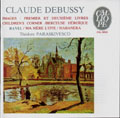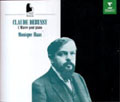Recommendable
discs |

    |
"Images,
1'ère série / Images, 2'ème série / Children's
Corner" (Deutsche Grammophon : 415 372-2)
Arturo Benedetti Michelangeli
(piano)
Michelangeli is a famous perfectionist as he did not permit to publish
his recordings unless the quality made his sensitive ears satisfy. That
philosophy is totally opposite from Samson François' as he attached
importance to enliven musical performance so that most of François
recordnings were directly recorded just one time for each track. Michelangeli
clinged to accomplish as perfect as possible, and considered every arpeggio,
pedaling, choice of tempo, and rubato. The logical perfectionistic approach
makes his Debussy extraordinary keen. Because every piece of Children's
Corner were based on a different vector in style so that sounds pretty
different from each other, a recording with continuous and well-ballanced
reasonability of interpretation is rarely to be found. Regarding with the
difficulty of this suite, Michelangeli-like 'passive- but- never be ruined'
perfectionist approach should be the most favorable. The feature of his
Debussy fill with some Viennish tight accent, which may make some listeners
feeling a bit of incongruity. Also, as for 'The snow is dancing', clear
arpeggio which he is good at get mashed a little bit, which look to disadvantage
of which of Paraskivesco's. However, instead of the inferiority, 'Cake-walk'
of this recording highlights the superiority. Because of the jazz-like
rhythm, most of the famous recordings were ruined the quality. But Michelangeli's
inspection of natural rhythm and reasonable accent arrengement eliminates
the awkwardness. He is not a positive winner of a tune but typical no-loser
of debussy. |

    |
"Images
1 ere, 2ème livres / Berseuse Héloïque / Children's
Corner (Debussy) : Ma Mère l'oye / Habanera (Ravel*)" (Calliope : CAL 9832)
Théodore Paraskivesco
(piano) Jacques Rouvier (piano)*
From the time on, he had started enjoying mainly his carrier as a educator
and sited in Paris so that he stopped to record any very often. Here, his
recordning of Debussy was no exception, the recordings were recorded in
1980's and it became difficult to purchase them (especially for 'etudes'
and 'preludes') by now, in spite of his quality of performance. This situation
is really misfortune. His debussy, reflecting his status as an educator,
can be described as it's through of penetrate and delicate interpretation
and performance. Although his 'Cake-walk' sounds with a little bit of awkwardness,
this recording has a supreme version of 'The snow is dancing'. The sublime
clearity and overhelming softness with rubato which is to the point give
delicate power of persuation to this performance. |

    |
Claude
Debussy "Préludes libre 2 / Elégie / Children's Corner"
(Pianovox
: PIA 538-2)
Alice Ader (piano)
Although she has been unprolific and merely done the recordings, all of
her small amount of Debussy recordings should be considered to be among
the best. Even though she seems already in middle age when she recorded
two volume of Debussy recordings in around 1998-9, her technic is highly
competent. Her style of Debussy can be characterized by bold felmata (which
makes exquisite naughts) and gigantic rubato strokes which construct three
dimentional tone space. Related interpretations would be those of Livía Rév and Zoltan Kocsis. One may claim this contains too much arbitrariness and such adventurous performance choose the listeners' favor. But still this is a warmly recommended disc as an second choice which has an individual and interesting voice. |

    |
"L'oeuvre
pour Piano" (Erato
: 4509-94827-2)
Monique Haas (piano)*
Monique Haas, an French prominent female pianist, had fortunately left complete recordings of Debussy and Ravel before she passed away for Erato. Above all, her Ravel recordings are as good as it have chosen the grand prix disc of French disc award. Her Debussy' s charm can be pointed out that of her modest interpretation and vivid arpeggio. Although her interpretation is a bit less-emotional in general, this 'Children's corner' demonstrates a typical example of her merit such that it does not contain significant ruins of interpretation, strong accent with clear tempo, and effective pedaling. However, her recordings for Erato have one mortal wound. Recording environment is seriously poor !! Despite there is no significant noise, and no monaural equipments in this recording, this piano sings dirtily !! mid-range swells out weirdly and sounds like a middle-age spread folks. Moreover, the sound is crackled. This regretable recording environment spoiled the virture of her performance. Be prepared to accept this fault. If you do, this will give you an pretty alternate to your disc library. |
The rate is just for the performance of 'Children's Corner' only. |




